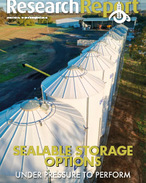This article is 8 years old. Images might not display.
The study revealed that by unlocking the full potential of ‘digital agriculture’ the value of agricultural production could conservatively increase by $20.3 billion and help achieve the industry’s goal of $100 billion in farm gate output by 2030.
The Australian Farm Institute project researcher Richard Heath said the P2D project, led by the Cotton Research and Development Corporation (CRDC) and supported by all 15 rural research and development corporations, delivered 13 key recommendations designed to catapult Australian agriculture into the digital age.
“A lack of producer control, on-farm connectivity and the under-utilisation of data has put Australia at a global disadvantage,” Mr Heath said.
“We’ve now got a pathway to transform the nation’s farm business management and decision making by adopting effective digital agriculture technologies. We just need to act,” he said.
Heath said the P2D recommendations call for a “big picture fix”, including a new Digital Agriculture Taskforce for Australia and collaborative efforts to secure data speeds and volumes and open access to game-changing datasets.
“Implementing the recommendations would break down the current barriers to digital transition, including poor connectivity, a lack of confidence in returns from investment in digital agriculture, poor knowledge and support to assess options, and trust and legal issues around data ownership,” Heath said.
“If we get this right, agriculture in the future will be digitally enhanced throughout the value chain from producer to consumer, through increased automation, smarter use of inputs, accelerated genetic gains and improved market access and biosecurity.
“The collection of data from machines and sensors is increasing rapidly in Australia and we have been a leading player in the development of precision agriculture tools. However, our AgTech market to provide tools for analysing data is in its infancy, compared to countries like Israel and the United States.”
National Farmers' Federation (NFF) President Fiona Simson said the report confirmed what farmers had suspected for years.
“Farmers have long recognised digital farming technologies have real potential to improve productivity and on-farm efficiency. Farm production was, on average, on an upward trajectory,” Ms Simson said.
"The opportunities for new technologies, such as artificial intelligence and the application of big data are a long way from being realised,” she said.
"The largest barrier to realising the benefits of these technologies has been poor internet connectivity.”
The NFF president said farmers have been frustrated for some time by a lack of connectivity which has hampered technology uptake.
"For many, investment in infrastructure in rural, regional and remote areas, where a huge amount of our agricultural production takes place, has been perceived as lacking a return on investment," Ms Simson said.
“However, this report demonstrates that there is a return on investment from connectivity infrastructure,” she said.
Specifically, the findings detail that agriculture alone can expect a 30% increase in value and deliver an overall increase of $24.6 billion to the national gross domestic product (a 1.5% increase on 2014-15 levels).
“When you consider the already significant contribution the sector makes to the Australian economy, this finding is incredible. It gives the government 24 billion reasons to focus on finding solutions to the data drought, so the farm sector can reach its potential.”























